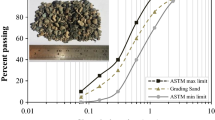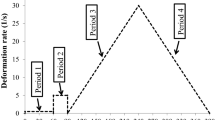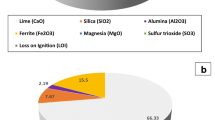Abstract
Artificial Neural Network (ANN) analysis has been established to forecast the Water/Cement (w/c) ratio values of cement pastes by using image analysis techniques in the scope of this study. W/c ratio values have reasonably great effects on the performance of cement based structural members. The service life or ultimate performances such as strength and durability characteristics are strongly affected by w/c ratios of cementitious materials. In this study, the relationship between microstructural phases such as unhydrated cement part, hydration products, capillary porosity, and w/c ratios predicted by ANN analysis, has been established. The predicted values are compared with estimated values obtained by proposed method in the literature. The study indicated that, using a contemporary data analysis technique, which is capable of searching nonlinear relationships more thoroughly, would result in more realistic prediction of the w/c ratios compared to the proposed method.
Similar content being viewed by others
References
ACI Committee 318 (2002). Building code requirements for structural concrete, (ACI 3118-02) and Commentary (ACI 318-02), ACI, Detroit.
ACI Standard 211.1 (1996). Standard practice for selecting proportions for normal, heavyweight, and mass concrete, ACI Manual of Concrete Practice, Part 1.
ACI 211.4R (1993). Guide for selecting properties for high strength concrete with Portland cement and fly ash, ACI, Detroit.
Adhikary, B. B. and Mutsuyoshi, H. (2006). “Prediction of shear strength of steel fiber RC beams using neural networks.” Construct. Build Mater., Vol. 20, No. 9, pp. 801–811.
Alshihri, M. M., Azmy, M., and El-Bisy, M. S. (2009). “Neural networks for predicting compressive strength of structural light weight concrete.” Construct. Build Mater., Vol. 23, No. 6, pp. 2214–2219.
Duda, R. O., Hart, P. E., and Stork, D. G. (2000). Pattern classification (2nd ed.), John Wiley & Sons.
Ince, R. (2004). “Prediction of fracture parameters of concrete by artificial neural networks.” Eng. Fract. Mech., Vol. 71, No. 15, pp. 2143–59.
Kewalramani, A. M. and Gupta, R. (2006). “Concrete compressive strength prediction using ultrasonic pulse velocity through artificial neural networks.” Auto. Construct., Vol. 15, No. 15, pp. 374–379.
Kjeilsen, K. O., Detwiler, R. J., and Gjurv, O. E. (1991). “Backscattered electron image analysis of cement paste specimens; Specimen preparation and analytical methods.” Cem. Conc. Res., Vol. 21, No. 2, pp. 388–390.
Kosmatka, S. H., Kerkhoff, B., and Panarese, W. C. (2002). Design and control of concrete mixtures, Editors: Steven H. Kosmatka, Beatrix Kerkhoff, and Willim C. Panarese, 14th ed., Portland Cement Association.
Lange, D. A., Jennings, H. M., and Shah, S. P. (1994). “Image analysis techniques for characterization of pore structure of cement based materials.” Cem. Conc. Res., Vol. 24, No. 5, pp. 841–853.
Lefik, M., Boso, D. P., and Schrefler, B. A. (2009). “Artificial neural networks in numerical modelling of composites.” Comput. Methods. Appl. Mech. Eng., Vol. 198, Nos. 21–26, pp. 1785–1804.
Matignon, R. (2005). Neural network modeling using sas enterprise miner, pp. 90.
Neville, A. M. (1995). Properties of concrete, Fourth Edition Addison Wesley Longman Ltd.
Onal, O. and Ozturk, A. U. (2010). “Artificial neural network application on microstructure-compressive strength relationship of cement mortar.” Advances in Engineering Software, Vol. 41, No. 2, pp. 165–169.
Ozturk, A. U. and Baradan, B. (2008). Porosity and mechanical properties of cement mortars based on Microstructural investigation/ Computational Materials, 978-1-60456-896-7, Nova Science Publishers, New York.
Scrivener, K. L., Patel, H. H., Pratt, P. L., and Parrott, L. J. (1987). “Analysis of phases in cement paste using backscattered electron images. In: L.J. Struble, P.W. Brown, editors. Microstructural development during hydration of cement.” Mater. Res. Soc. Symp. Proc., Vol. 85, pp. 67–76.
Selver, M., Ardal, E., Önal, O., and Akay, O. (2008). “Predicting uniaxial compressive strengths of brecciated rock specimens using neural networks and different learning models.” 23rd International Symposium on Computer and Information Sciences, STANBUL, October.
Stutzman, P. E. and Clifton, J. R. (1999). “Sample preparation for scanning electron microscopy.” In: Proceedings of 21st International Conference — Cement Microscopy, Las Vegas, pp. 10–22.
Venkiteela, G., Gregori, A., Sun, Z., and Shah, S. P., (2010). “Artificial neural network modeling of the early-age dynamic Young’s modulus of normal concrete.” ACI Materials Journal, Vol. 107, No. 3, pp. 282–290.
Werbos, P. J. (1994). The roots of backpropagation: From ordered derivatives to neural networks and political forecasting, John Wiley and Sons, New York, Chichester, Brisbane, Toronto and Singapore.
Wong, H. S. and Buenfeld, N. R. (2009). “Determining the watercement ratio, cement content, water content and degree of hydration of hardened cement paste: Method develop and validation on paste samples.” Cem. Concr. Res., Vol. 39, No. 10, pp. 957–965.
Wong, H. S., Head, M. K., and Buenfeld, N. R. (2006). “Pore segmentation of cement-based materials from backscattered electron images.” Cem. Concr. Res., Vol. 36, No. 6, pp. 1083–1090.
Zhao, H. and Darwin, D. (1992). “Quantitative backscattered electron analysis for cement paste.” Cem. Concr. Res., Vol. 22, No. 4, pp. 695–706.
Author information
Authors and Affiliations
Corresponding author
Rights and permissions
About this article
Cite this article
Ozturk, A.U., Onal, O. Identification of water/cement ratio of cement pastes, basing on the microstructure image analysis data and using artificial neural network. KSCE J Civ Eng 17, 763–768 (2013). https://doi.org/10.1007/s12205-013-0156-9
Received:
Revised:
Accepted:
Published:
Issue Date:
DOI: https://doi.org/10.1007/s12205-013-0156-9




